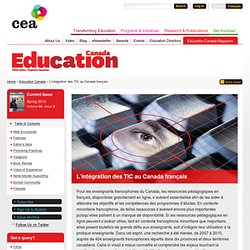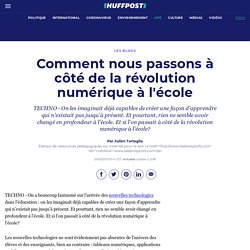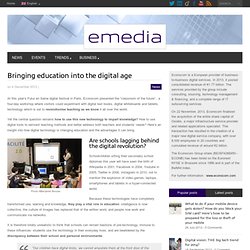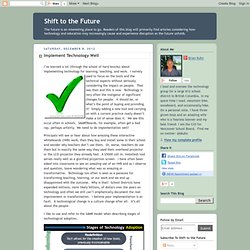

L’intégration des TIC au Canada français. Introduction.

Faire ses premiers pas vers la classe inversée. Modèle samr avril_2013. 4 Stages: The Integration Of Technology In Learning. The 4 Stages Of The Integration Of Technology In Learning by Terry Heick For professional development around this idea or others you read about on TeachThought, contact us.

Technology can be used in the learning process in a variety of ways. Some are supplementary, serving the original design of the classroom and usually automate some previously by-human task or process–grading multiple choice assessments, searching for a source of information, or sharing messages and other data across large groups. Julien Tartaglia: Comment nous passons à côté de la révolution numérique à l'école. TECHNO - On a beaucoup fantasmé sur l'arrivée des nouvelles technologies dans l'éducation : on les imaginait déjà capables de créer une façon d'apprendre qui n'existait pas jusqu'à présent.

Et pourtant, rien ne semble avoir changé en profondeur à l'école. Technology in schools: saving money with cloud, open source and consortia. Staffing costs aside, ICT represents one of the largest elements of a school's budget, so it is no surprise that when savings need to be made, spending on both equipment and software comes under scrutiny.

But with the role of technology as a teaching tool and in society at large growing all the time, the trick is delivering savings without damaging pupils' education or putting them at a disadvantage in the world outside school. One solution is open source software, moving away from proprietorial systems where users pay for a licence. This is the route taken by Pool Academy in Cornwall, which has moved four of its six servers to the free CentOS Linux platforms.
Windows is still in place on end-users' screens, ensuring pupils are familiar with systems they will encounter outside school. The change is saving around £3,000 a year in licensing costs, according to the schools' ICT manager Phil Jones. What Is The HyFlex Learning Model? Major EdTech Trends for 2013. How To Know If You're Correctly Integrating Technology. A common question that we hear from teachers about integrating technology into their classrooms is, “how do I know if I’m doing it right?” We love to hear this question because that tells us that the teacher is starting to analyze and evaluate how they are integrating technology and are looking for a way to gauge their effectiveness. We feel that the Technology Integration Matrix (TIM) best addresses the question of “doing it right.” According to the Arizona K-12 Center at Northern Arizona University , “the TIM is designed to assist schools and districts in evaluating the level of technology integration in classrooms and to provide teachers with models of how technology can be integrated throughout instruction in meaningful ways.”
There is more than one version of the TIM but the one that we most commonly refer to with our staff was produced by the Arizona K12 Center at NAU. Intégration des TIC à l'école : un changement de mentalité nécessaire. Le rapport de l’ Étude des motifs d’utilisation et des profils d’adoption de matériel scolaire (didactique) informatisé (MDI) par des enseignantes et enseignants du primaire au Québec a été remis à la Direction des ressources didactiques du MELS à la fin du mois de mars 2008.
Dans ce rapport, l’équipe de recherche de l’Université de Sherbrooke, dirigée par François Larose, conclut que, tant que les enseignants ne modifieront pas leur rapport avec le savoir, de même que leur conception de la démarche d’apprentissage des élèves, les ressources informatiques demeureront des ressources didactiques parmi tant d’autres; celles-ci pouvant être utilisées en alternance avec les autres ressources, principalement pour entretenir la motivation des élèves.
Donc, malgré l’implantation du renouveau pédagogique qui devait donner une plus grande place aux TIC dans les salles de classe, l’utilisation des TIC se fait toujours selon un modèle traditionnel. Équipe École 2.0's Public Library. Les écoles numériques. A Pedagogical Framework For Digital Tools. As a consequence of society’s digitization it becomes increasingly important to use technology in education, in primary as well as in secondary education. Students must achieve a number of digital literacies and competences that can enable them to succeed in a world where digital tools are a natural part of everyday life. In order to ensure that students acquire the necessary digital literacies and competences, and to ensure that they can critically think, it is important that they are presented with a range of digital tools and gain an understanding of the tools’ capabilities. This places high demands on the teacher. As a teacher it can be difficult to keep up with the new digital opportunities, and it can be hard to assess which digital tools students should be presented to, and in which contexts it is appropriate to use them in education.
The framework is based on a distinction between a monological , a dialogical , and a polyphonic form of teaching. The monological form of teaching.
BYOD. 12 YouTube Videos Every Online Educator Should View. What are the benefits for the teacher and learner in the context of open education and OER? How does a blended-learning school boost student achievement? How can we design the schools for 21st Century Learning? How will be the classroom of tomorrow? What are the tools and resources for the 21st Century Educator? At the 12 YouTube Videos Every Online Educator Should View you will be able to answer the above questions and even more. 1) The Future Starts Now - 2012 edition The Norwegian Centre for ICT in Education (www.iktsenteret.no).
7 Key Findings for Successful Education Technology Integrations. Continuing with the theme of measurable successes in education technology implementations that we’ve explored in a number of articles over the last few months, today we take a look at Project Red.

Project RED conducted a national study of education technology focused on student achievement and financial implications. The coalition of three research organizations surveyed and studied nearly 1,000 schools and uncovered a replicable design for successfully introducing technology into the classroom, improving student performance, and yielding cost benefits. This exciting research endeavor developed 11 “success measures” and 22 independent measures and incorporated these into a survey tool that was central to the project’s effort to identify and prioritize the factors that make some U.S. K-12 technology implementations perform dramatically better than others. Project Red’s research produced 7 key findings, summarized briefly below (check out the complete findings for further details).
Le numérique change la pédagogie … à condition de changer la pédagogie ! Comment réinventer l’éducation avec le numérique ? At this year’s Futur en Seine digital festival in Paris, Econocom presented the “classroom of the future” , a four-day workshop where visitors could experiment with digital text books, digital whiteboards and tablets, technology which is set to revolutionise teaching as we know it all over the world.

Yet the central question remains how to use this new technology to impart knowledge? How to use digital tools to reinvent teaching methods and better address both teachers and students’ needs? Here’s an insight into how digital technology is changing education and the advantages it can bring. Photo ©Benjamin Boccas Are schools lagging behind the digital revolution? Implement Technology Well. I’ve learned a lot (through the school of hard knocks) about implementing technology for learning, teaching, and work.

I naively used to focus on the tools and the technical aspects without seriously considering the impact on people. That was then and this is now. Technology is very often the instigator of significant changes for people. It should be, or what’s the point of buying and providing it? 3 Ways One School Is Integrating Technology. Source: GeekLover As we look ahead to 2013, educators are developing ways for their schools to adapt in our rapidly-changing technological world to ensure the best skill sets and success for their students. Beaver Country Day School , a leading, independent school for grades 6-12 just outside of Boston, lists the top 3 ways the school utilizes technology to improve student learning experiences: Screen time has its perks. In a 1:1 laptop environment for all students and teachers, web 2.0 skills and related computer projects are integrated throughout daily curriculum and across all subjects.
Trained teachers, called “Technology Integration Specialists,” guide teachers to de-emphasize the specialization of computer technology and improve students’ collaboration, analytical and research skills. Remove the Facebook firewall. Teach for the future.